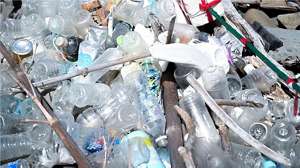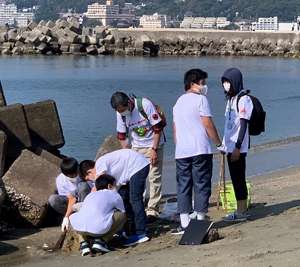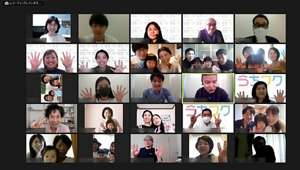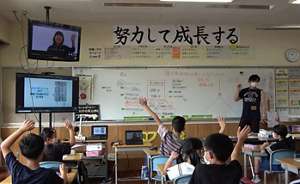Progress Report of Kao and Wakayama City's Cooperation Agreement to Promote the SDGs
In October 2020, Kao Corporation concluded a cooperation agreement with Wakayama City for promotion of the Sustainable Development Goals (SDGs). Kao is aiming to make contributions through its wide-ranging business fields and its research technologies that support them to Wakayama City's efforts toward the SDGs and to the sustainable development of the local community of Wakayama City. A one-year timeframe had initially been planned for this cooperation, but it has been decided to extend it for an additional year. Following is a report of the cooperation's progress to date.
1. Activities to pass down a rich natural environment, including the ocean
(1) Research on marine plastic waste and promotion of recycling
(2) Begin activities for preservation of the ocean environment
● Kao began a survey together with Tomoyo Chiba, associate professor of Osaka Prefecture University, on the state of marine plastic waste that flows out from Osaka Bay and washes up at Tomogashima*1 in Wakayama City.

Marine plastic waste at Tomogashima
● Kao cooperated with the Furusato Challenge conducted by Kindai University Junior High School, participating in cleanup activities and conducting a survey of marine plastic waste at Kataonami Beach in October 2020 and at Hamanomiya Beach in March 2021. Kao also provided learning opportunities, including offering online tours of the Kao Eco-Lab Museum*2 and having Kao researchers provide advice for giving presentations at the Children's Ocean Meeting*3 .

Cleanup activity at Kataonami Beach
● Kao supported an event organized by the Kada Tomogashima Institute for Environmental Strategies held in June 2021 at Tomogashima with cooperation from Wakayama City. Participants created works of art using articles from the ocean washed ashore at Tomogashima and communicated the message of wanting to protect the pristine beauty of the ocean around the islands, which are a tourist attraction.
● Kao furthered research on reusing recovered marine plastic to make tables and chairs for oceanside facilities, and using it as a road strengthening agent on the oceanside cycling path.
● Kao furthered research to contribute to realizing a "rich ocean," including the ocean surrounding Wakayama City.
-
* 1 Group of uninhabited islands to the northwest of Kada, Wakayama. Tomogashima is the collective name for the four islands of Okinoshima, Jinoshima, Torajima and Kamijima, which are tourist attractions located within Setonaikai National Park.
-
* 2 Museum where visitors can experience Kao's leading-edge ecological technologies, located within Kao's Wakayama Plant
-
* 3 Event to deepen learning for protecting Wakayama's rich ocean organized by Wakayama City
2. Activities to realize a local community that is highly livable
● Aiming to create an environment where raising children is easier, Kao held a workshop for the "Home Excitement" project for 14 families raising children with the objective of reframing how they approach housework. A total of three sessions were held on the topics of 1) understanding the actual situation of housework and child-rearing, 2) communication to alleviate dissatisfaction associated with housework and child-rearing and 3) shortcuts to lessen the burden of housework and child-rearing.

"Home Excitement" project workshop
● Kao created a tool (questionnaires and results chart) to prompt changes in awareness toward housework and child-rearing with the cooperation of Tomoari Miki, a researcher of sharing housework. Use of the tool is starting in Wakayama City, with the goal of having it used nationwide.
3. Activities to develop human capital for the future
● Kao developed a program for engaging in thinking about and solving the problem of marine waste plastic, jointly with an elementary school affiliated with Wakayama University Faculty of Education. Kao employees provided online lessons on ways to reduce plastic waste and recycling. The employees cooperated in giving lessons throughout the year, and also gave lessons where they offered advice to children spreading information about the activities in posters and videos.

Lesson by a Kao employee at an elementary school affiliated with Wakayama University Faculty of Education
● In FY 2021, Kao created a lesson program including materials based on the program for an elementary school affiliated with Wakayama University Faculty of Education, and provided it to public elementary schools in Wakayama City upon request through the Wakayama City Board of Education. Kao employees also gave online lessons on ways to reduce plastic waste and recycling.
● Based on these activities, Kao developed a program to nurture citizen engagement with society to identify the problems of plastic waste and marine plastic waste that are experienced close to home and community challenges, and become an active participant in solving challenges. Kao aims to provide the educational program nationwide.
Initiatives for Kao's ESG Strategy, the Kirei Lifestyle Plan and plastic circularity in society
Recognizing its responsibility as an enterprise that provides products which people use on a regular basis in their daily lives, Kao takes active steps to reduce the environmental footprint of its products throughout the entirety of the product lifecycle. In April 2019, Kao launched the Kirei Lifestyle Plan, its ESG (environmental, social and governance) strategy, which incorporates 19 key leadership actions. Kao's purpose is to create a Kirei life for all. The Japanese word 'kirei' describes something that is both clean and beautiful. For Kao, Kirei not only encapsulates appearance, but also attitude—to create beauty for oneself, other people, and for the world around us. The Kirei Lifestyle Plan aims to integrate ESG as the foundation of its management to accelerate business growth and create products and services of better value for consumers and society.
Regarding the issue of plastic waste, which is a significant problem for society, in 2018, Kao announced its "Our Philosophy & Action on Plastic Packaging" declaration, and are abiding by the 4Rs: Reduce, Replace, Reuse, Recycle. We are substantially reducing the amount of plastic used in our packaging, by making them thinner, reusable, refillable, and reduced in volume, as well as improving our liquid concentration. We are also developing packaging that is easier to recycle. Plus, we will make efforts to switch away from fossil fuel-based plastics toward the use of sustainable materials.
In September 2019, Kao announced that it would be focusing on Innovation in Reduction and Innovation in Recycling, so as to help realize a society characterized by effective plastic resource circulation. In the area of Innovation in Recycling, we are collaborating with other companies and organizations on the horizontal recycling of plastic packaging. Initiatives for which we are undertaking verification testing include the recycling of film packaging made using multiple different materials, which in the past has been considered difficult to recycle, as well as recycling of mono-material film packaging (which is made using a single material), and of mono-material bottle containers. We are also conducting demonstration testing for many other projects, including recycling of items other than packaging, such as used diapers.
By integrating ESG into the core of its company management, Kao will drive business growth and better serve consumers and society through its enhanced products and services. With this socially conscious ethos, Kao will create a Kirei life for all—providing care and enrichment for the life of all people and the planet.

-
* This news release is a translation of a Japanese-language news release dated November 17, 2021.
About the Kirei Lifestyle Plan
Over the past 130 years, Kao has worked to improve people's lives and help them realize more sustainable lifestyles—a Kirei Lifestyle. The Japanese word 'kirei' describes something that is clean, well-ordered and beautiful, all at the same time. The Kao Group established its ESG strategy, the Kirei Lifestyle Plan in April 2019, which is designed to deliver the vision of a gentler and more sustainable way of living. By 2030, Kao aims to empower at least 1 billion people, to enjoy more beautiful lives and have 100% of its products leave a full lifecycle environmental footprint that science says our natural world can safely absorb.
For more information please, click
About Kao
Kao creates high-value-added products that enrich the lives of consumers around the world. Through its portfolio of over 20 leading brands such as Attack, Bioré, Goldwell, Jergens, John Frieda, Kanebo, Laurier, Merries, and Molton Brown, Kao is part of the everyday lives of people in Asia, Oceania, North America, and Europe. Combined with its chemical division, which contributes to a wide range of industries, Kao generates about 1,400 billion yen in annual sales. Kao employs about 33,000 people worldwide and has 130 years of history in innovation. Please visit the Kao Group website for updated information.
Media inquiries should be directed to:
Corporate Strategy
Kao Corporation
